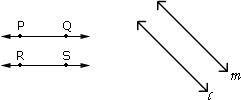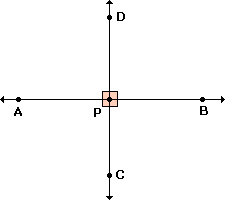Today we are going to put some light on the geometry of grade V of ICSE. grade V is the is last class of primary section and in this class you do revision of all the topics that you have learned and with this you learn several new topics. In the last article of the same grade we have discussed about geometry and the very first topic of the same we have discussed construction of the basic geometric figures and today you will learn, Parallelism, Perpendicularity, and Congruence.
Afore we move to parallelism, first talk about parallel lines. Parallel lines are distinct lines, which lie in the same plane and they never intersect each other. With this, parallel lines also have same slope.

Parallelism is defined as the state of being parallel or corresponding in some way. When two lines or object moves parallel to each other we define it as parallelism.
Now, the next one that is Perpendicularity, do you know what does perpendicular means? Perpendicular means when an object is placed at exactly 900. Perpendicular lines are those lines that intersect each other at a right angle or at 900. If two lines are perpendicular to each other, then the product of their slopes is always equal to – 1. Example:
 Perpendicularity is the phenomenon in which a straight line is placed at 900 to given plane, line or surface. The equation of perpendicularity is given as:
Perpendicularity is the phenomenon in which a straight line is placed at 900 to given plane, line or surface. The equation of perpendicularity is given as:
ay – bx + k =0
It represents for different values of k a family of lines perpendicular to the lines ax + by + c = 0.
Now the last topic of today i.e. Congruence,
In this we deal with congruent triangles. What do you understand by congruent triangles, it means having the same measure. Similarly the congruent angles are those angles that have same measure. You all know equilateral triangles; it has all its angle equal to 600. In the same way concurrent triangles also have same measures. Congruent Figures have the same shape and size.
 Congruent Segments have the same length.
Congruent Segments have the same length.
 Example: Line CD bisects another line AB at point P. Name any two congruent angles formed.
Example: Line CD bisects another line AB at point P. Name any two congruent angles formed.
Output:
Step 1: When a line bisects another line, four right angles are formed.
 Step 2: Two such angles are angle CPB and angle APD.
Step 2: Two such angles are angle CPB and angle APD.
This is all about the three topics I mentioned above. Geometry is very simple branch of mathematics and in this you have to only deal with figures, shapes and their properties. Geometry is simple if you do practice on daily basis. Learn the topic on the very same day and clear all your doubts. To score good grade do the practice and become master of the subject.
In upcoming posts we will discuss about Fractions in Grade V. Visit our website for information on prime factorization
Afore we move to parallelism, first talk about parallel lines. Parallel lines are distinct lines, which lie in the same plane and they never intersect each other. With this, parallel lines also have same slope.

Now, the next one that is Perpendicularity, do you know what does perpendicular means? Perpendicular means when an object is placed at exactly 900. Perpendicular lines are those lines that intersect each other at a right angle or at 900. If two lines are perpendicular to each other, then the product of their slopes is always equal to – 1. Example:

ay – bx + k =0
It represents for different values of k a family of lines perpendicular to the lines ax + by + c = 0.
Now the last topic of today i.e. Congruence,
In this we deal with congruent triangles. What do you understand by congruent triangles, it means having the same measure. Similarly the congruent angles are those angles that have same measure. You all know equilateral triangles; it has all its angle equal to 600. In the same way concurrent triangles also have same measures. Congruent Figures have the same shape and size.


Output:
Step 1: When a line bisects another line, four right angles are formed.

This is all about the three topics I mentioned above. Geometry is very simple branch of mathematics and in this you have to only deal with figures, shapes and their properties. Geometry is simple if you do practice on daily basis. Learn the topic on the very same day and clear all your doubts. To score good grade do the practice and become master of the subject.
In upcoming posts we will discuss about Fractions in Grade V. Visit our website for information on prime factorization


